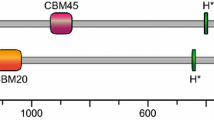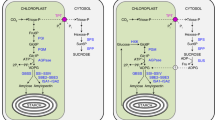Abstract
The contributions of ADP-glucose pyrophosphorylase (EC 2.7.7.27) and starch-branching enzyme (EC 2.4.1.18) to the control of the rate of starch synthesis in developing pea (Pisum sativum L.) embryos was investigated. Estimates were made of the deviation indices for changes in the activities of these enzymes at a point approximately halfway through embryo development, when starch was accumulating rapidly. The values for the deviation indices, and thus the flux control coefficients, were 0.1 for ADP-glucose pyrophosphorylase and 0.05 for starch-branching enzyme. Both values are low, suggesting that neither enzyme is of overriding importance in the control of starch synthesis in pea embryos.
Similar content being viewed by others
Abbreviations
- ADPGpp:
-
ADP-glucose pyrophosphorylase (adenosine 5′-diphosphoglucose pyrophosphorylase)
- SBE:
-
starchbranching enzyme (1,4-α-d-glucan-6-glycosyl transferase)
- SSS:
-
soluble starch synthase (ADP glucose: 1,4-α-d-glucan-4-glucosyl transferase)
References
ap Rees, T., Hill, S.A. (1994) How should we study the regulation of plant metabolism? Plant Cell Environ. 17, 587–599
Bhattacharyya, M.K., Smith, A.M., Ellis, T.H.N., Hedley, C.L., Martin, C. (1990) The wrinkled-seed character of pea described by Mendel is caused by a transposon-like insertion in a gene encoding starch-branching enzyme. Cell 60, 115–122
Burton, R.A., Bewley, J.D., Smith, A.M., Bhattacharyya, M.K., Tatge, H., Ring, S., Bull, V., Hamilton, W.D.O., Martin, C. (1995) Starch branching enzymes belonging to distinct enzyme families are differentially expressed during pea embryo development. Plant J. 7, 3–15
Denyer, K., Hylton, C.M., Smith, A.M. (1994) The effect of high temperature on starch synthesis and the activity of starch synthase. Aust. J. Plant Physiol. 21, in press
Foster, J.M., Smith, A.M. (1993) Metabolism of glucose 6-phosphate by plastids from developing pea embryos. Planta 190, 17–24
Gross, P., ap Rees, T. (1986) Alkaline inorganic pyrophosphatase and starch synthesis in amyloplasts. Planta 167, 140–145
Hedley, C.L., Lloyd, J.R., Ambrose, M.J., Wang, T.L. (1994) An analysis of seed development in Pisum sativum XVII. The effect of the rb locus alone and in combination with r on the growth and development of the seed. Ann. Bot. 74, 365–371
Heinrich, R., Rappoport, T.A. (1974) A linear steady-state treatment of enzymatic chains. General properties, control and effector strength. Eur. J. Biochem. 42, 89–95
Heldt, H.W. (1980) Measurement of metabolite movement across the envelope and of the pH in the stroma and the thylokoid space in intact chloroplasts. Methods Enzymol. 69, 604–613
Hill, L.M. (1993) The source of carbon for starch synthesis by amyloplasts from developing pea embryos. PhD thesis, University of East Anglia, Norwich, UK
Hill, L.M., Smith, A.M. (1991) Evidence that glucose 6-phosphate is imported as the substrate for starch synthesis by the plastids of developing pea embryos. Planta 185, 91–96
Hylton, C., Smith, A.M. (1992) The rb mutation of peas causes structural and regulatory changes in ADP glucose pyrophosphorylase from developing embryos. Plant Physiol. 99, 1626–1634
Jenner, C.F., Denyer, K., Hawker, J.S. (1994) Caution on the use of the generally accepted methanol precipitation technique for the assay of soluble starch synthase in crude extracts of plant tissues. Aust. J. Plant Physiol. 21, 17–22
Jenner, C.F., Siwek, K., Hawker, J.S. (1993) The synthesis of [14C]starch from [14C]sucrose in isolated wheat grains is dependent upon the activity of soluble starch synthase. Aust. J. Plant Physiol. 20, 329–335
Jones, D.A. (1994) A guide to crossing peas. J. Biol. Educ. 28, 154–156
Kacser, H., Burns, J.A. (1973) The control of flux. Symp. Soc. Exp. Biol. 27, 65–107
Kacser, H., Burns, J.A. (1981) The molecular basis of dominance. Genetics 97, 639–666
Keeling, P.L., Bacon, P.J., Holt, D.C. (1993) Elevated temperature reduces starch deposition in wheat endosperm by reducing the activity of soluble starch synthase. Planta 191, 342–348
Müller-Röber, B., Sonnewald, U., Willmitzer, L. (1992) Inhibition of the ADP-glucose pyrophosphorylase in transgenic potatoes leads to sugar-storing tubers and influences tuber formation and expression of tuber storage protein genes. EMBO J. 11, 1229–1238
Neuhaus, H.E., Stitt, M. (1990) Control of photosynthate partitioning. Impact of reduced activity of ADP-glucose pyrophosphorylase or plastid phosphoglucomutase on the fluxes to starch and sucrose in Arabidopsis thaliana (L.) Heynh. Planta 182, 445–454
Small, J.R., Kacser, H. (1993) Responses of metabolic systems to large changes in enzyme activities and effectors. 1. The linear treatment of unbranched chains. Eur. J. Biochem. 213, 613–624
Smith, A.M. (1988) Major differences in isoforms of starch-branching enzyme between developing embryos of round- and wrinkled-seeded peas (Pisum sativum L.). Planta 175, 270–279
Smith, A.M., Bettey, M., Bedford, I.D. (1989) Evidence that the rb locus alters the starch content of developing pea embryos through an effect on ADP glucose pyrophosphorylase. Plant Physiol. 89, 1279–1284
Author information
Authors and Affiliations
Additional information
We are grateful to Cliff Hedley (John Innes Centre) for the seeds of near-isogenic lines of pea, to James Brown (John Innes Centre) for statistical analysis (Genstat 5), to Cathie Martin, Rod Casey and Chris Hylton for their constructive criticism of the manuscript, to Rachel Burton, Josephine Craig, Chris Hylton, James Lloyd, Jacqueline Marshall and Kim Tomlinson for help with the plastid preparations and to Jacqueline Marshall for help with the enzyme assays. This work was supported by funding from the Biotechnology and Biological Sciences Research Council under the ‘biochemistry of metabolic regulation in plants’ initiative and from the European Community under contract C11* 0417-UK (SMA).
Rights and permissions
About this article
Cite this article
Denyer, K., Foster, J. & Smith, A.M. The contributions of adenosine 5′-diphosphoglucose pyrophosphorylase and starch-branching enzyme to the control of starch synthesis in developing pea embryos. Planta 197, 57–62 (1995). https://doi.org/10.1007/BF00239939
Received:
Accepted:
Issue Date:
DOI: https://doi.org/10.1007/BF00239939




